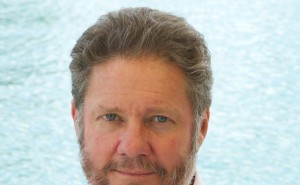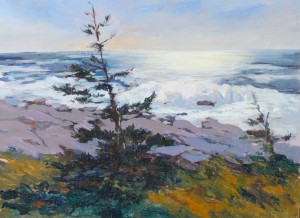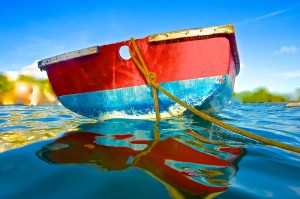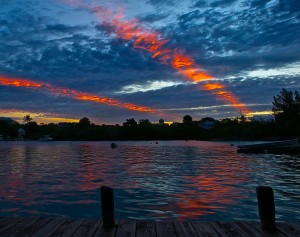* This was a 45 minute interview and for the sake of keeping it organized and mostly to the point I took the leeway of editing the interview.
I walked into the art studio with Mr. Masters and the interview began without any formal questioning, so I began recording what Mr. Masters was saying in his conversation. He had turned up some reggae music in the background and told me his class had the loudest speakers out of any art room in the world. He had hung a lot of his paintings and photographs around the room for me to look at while he began to talk.
*Reggae music playing in the background.
SM: …When you serve up something and deliver something that is not expected. If we are going to be on this planet we may as well have fun and just smile our way through it. What I think most important is in our education process we think the teachers are supposed to teach, but really the students are supposed to learn and sometimes those are very different things. Who owns the learning? and if it’s the students you’ve got a classroom. You’ve got a classroom full of people who you’ll never forget. And any talk about my work should come through my classroom because this is where I learn. I learn in my classroom and I have a blast. Kids are often remarking on my work and they begin to develop self-confidence. If they take somebody who they know makes a living making images and they make a criticism, or a constructive piece of guidance and I take it. And I always take it, I always take it no matter what and I put it into action right in front of them, then they come away thinking hey, I am somebody. As a student, this guy just took my advice. What a cool thing… Kids like to be taught by kids. They would prefer to be taught by kids than by teachers because most teachers are into teaching and not into learning. As soon as you get one into learning, there is an exciting teacher… If you try you are experimenting and you are creating because you are allowing yourself to take the risk. And you might fail. You might make mistakes. How cool a way to learn… F’s are medieval. What we need to do is find ways to treat any fails. Any errors along the way, any mistakes, as part of the journey because sometimes those fails will take you into a different place. And that is one aspect. There are no F’s. And kids need to set their own standards… So now they are curious. Ooh curiosity is just something that just drives this engine. Roped work doesn’t, but curiosity. And if it’s self driven curiosity you can’t beat that because no one is telling you what to do. You’re in charge. Holy smokes, kids in charge of school? This is a really nice thought, and for me this kind of releases the teacher from an arcane method of failing. Now you could steer the enthusiastic, make mistakes, and just celebrate the whole way through… A teacher has to be more flexible. Instead of delivering one lecture you’ve got to dance with 25 active minds. You should go home exhausted at 5:30… And this all translates into my work. I am not a technician.
CM: And I just want to direct this a little bit.
SM: Taking risk. This is where we are, that is the preamble.
CM: Can you please tell me about your educational background? Where did you go to school?
SM: It was a fairly traditional English education here in Bermuda until I went to Hotchkiss and we were good with sciences and math here in the 50s and 60s. What they weren’t good at was the whole socializing aspect and making the student feel as though they were part of the environment. And that sort of started to come about when I went to boarding school. Beginning when I went to boarding school all of a sudden I saw that woah, students had real respect for their teachers and teachers had real respect for the students. So the one had to come before the other. The teachers had to show respect for the student and all of a sudden, students now are glued. They are an important human being in this educational environment. And Hotchkiss to Williams and then back to Bermuda where I began teaching.
CM: And at Williams what did you major in?
SM: Most of what I took was art history. I learned about what people did because it wasn’t a technical school. It was all about what kind of thinking went into the building of the work, whatever it was. And the question was how could you take your thinking, sometimes whimsical thinking and what were some of the range of tools you could use. And I wasn’t really ready for it at that point. I was kind of an immature student, but thinking on it I’ve got that in my genes now.
CM: If you could be a student again what would you do differently?
SM: I’d do absolutely everything experientially. Experiential education is such an important thing, because we often keep kids out of the world in school, and then we turn them loose on the world and they have had no world experience so now they have to try and figure what to do with their school and put it to use. But if along the way they have had experience of making stuff happen. And disasters, because that’s part of the deal, then all of a sudden their learning curve goes way up steeper.
CM: As a student, if I wanted to incorporate art into my future what are your suggestions?
SM: Almost everything we do, both giving and receiving information, picking up details… there is a visual component to everything. Can you imagine going to an orchestra concert and not being allowed to see the musicians? Nobody has ever said did you hear Beyonce? They say did you see Beyonce? You are stimulated by environments where visual components are an important part of it.
CM: You work with both mediums of painting an photography. I was wondering how you think technology will change art in the future? And do you think that art related to technology such as computer graphics and photography will become more prominent? And what are you more drawn toward?
SM: The camera allows us to manipulate images or ideas very quickly so it’s not all about painting an image onto a surface to look it, it is all about what you do with that image. Photography is a fantastic thing to have as a learning medium, but also as a teaching medium. For instance, if you want to show your friends something you learned, you don’t even have to stop your car to take a picture and holy smokes the sky is the limit. Look what they are able to do in films – moving pictures. You can do absolutely anything you want when it comes to picture. I believe that the whole idea of photography and computer technology is absolutely accessible to everybody… I find that the photography give me a immediate gratification. I can post my photo to the internet and get immediate responses. Here is the key. We don’t make art just for ourselves. We use images to communicate our ideas visually. That is a really important part. It used to be that photography was an event – it was a journalist way of seeing things. It used aggressive terms. Did you catch something? Did you shoot something? For the first 150 years of photography there wasn’t much of a process. But now you can manipulate the pixels to convey an image. Photographs still ride this dicey line of if its real. And if you use photo shop is that against the rules? Everything we see in magazines is photo shopped so we live world. I don’t use Photoshop because it is too complicated, but I would if I could. In the same way I do it in painting. I go for stuff and it might work or it might not. The painting process takes place over a period of time and that part of the magic of it. That’s where is used be different. Painting took time and photography didn’t. Now both mediums have equal importance.
CM: Where do you plan on going with your own art?
SM: Essentially I want to keep learning stuff. And I learn about things through exploring them through painting and photography. So in my journey I get to experiment and I get to learn stuff. When my learning stops I’m pretty close to dead.
CM: What inspires you?
SM: What inspires me is to share it. When people share with me and I share with other people, that collaborative experience is what makes us human. Your emotions get involved, the knowledge base you have is increased.





